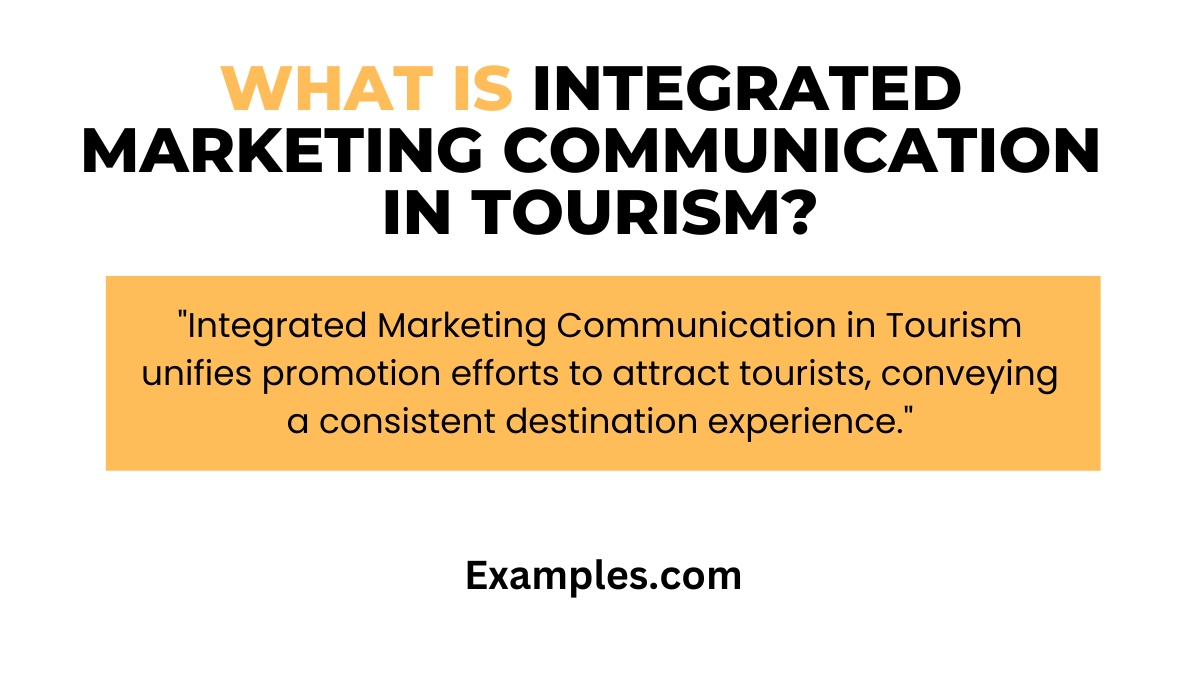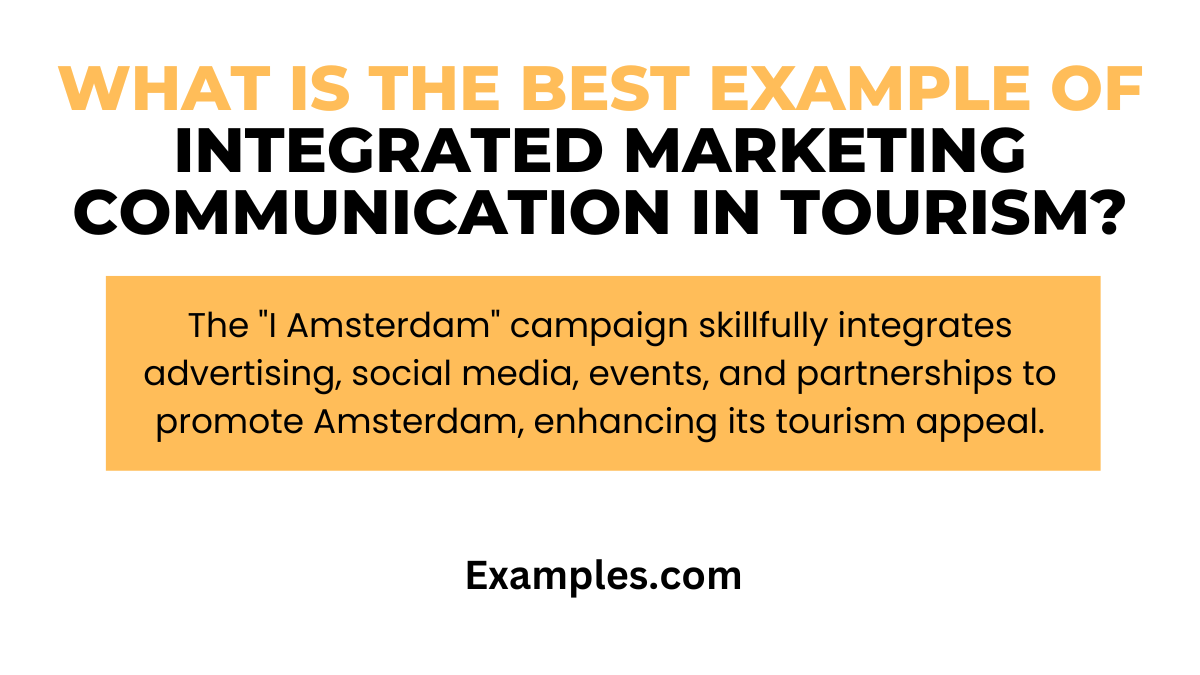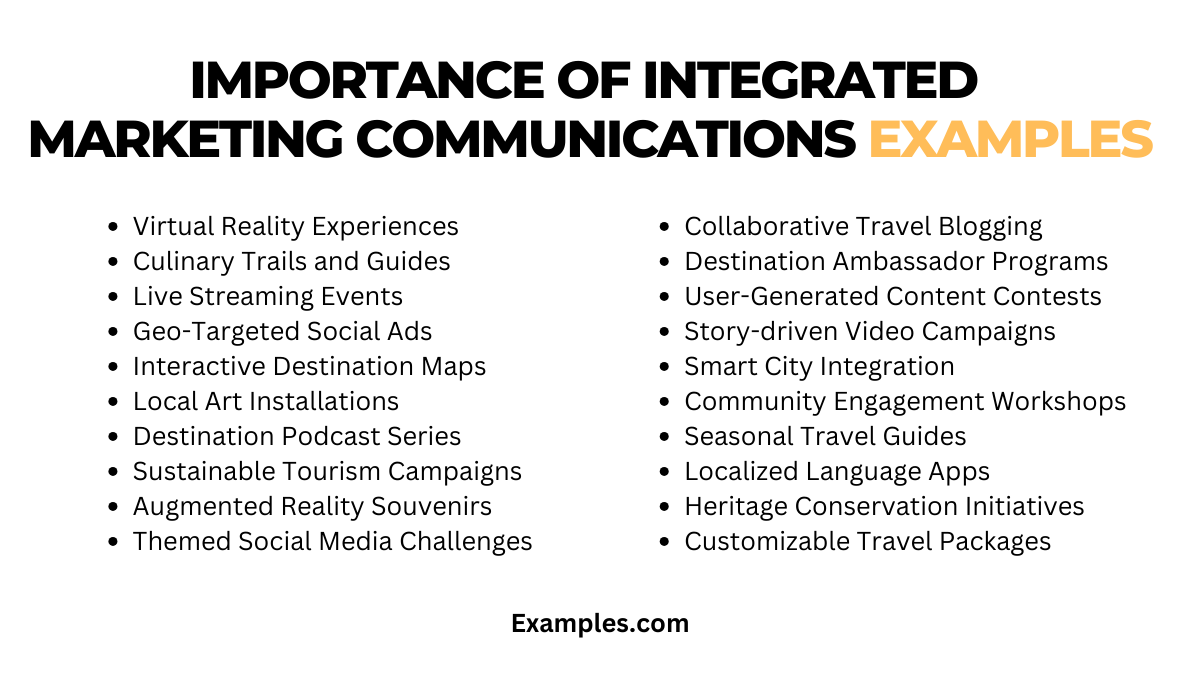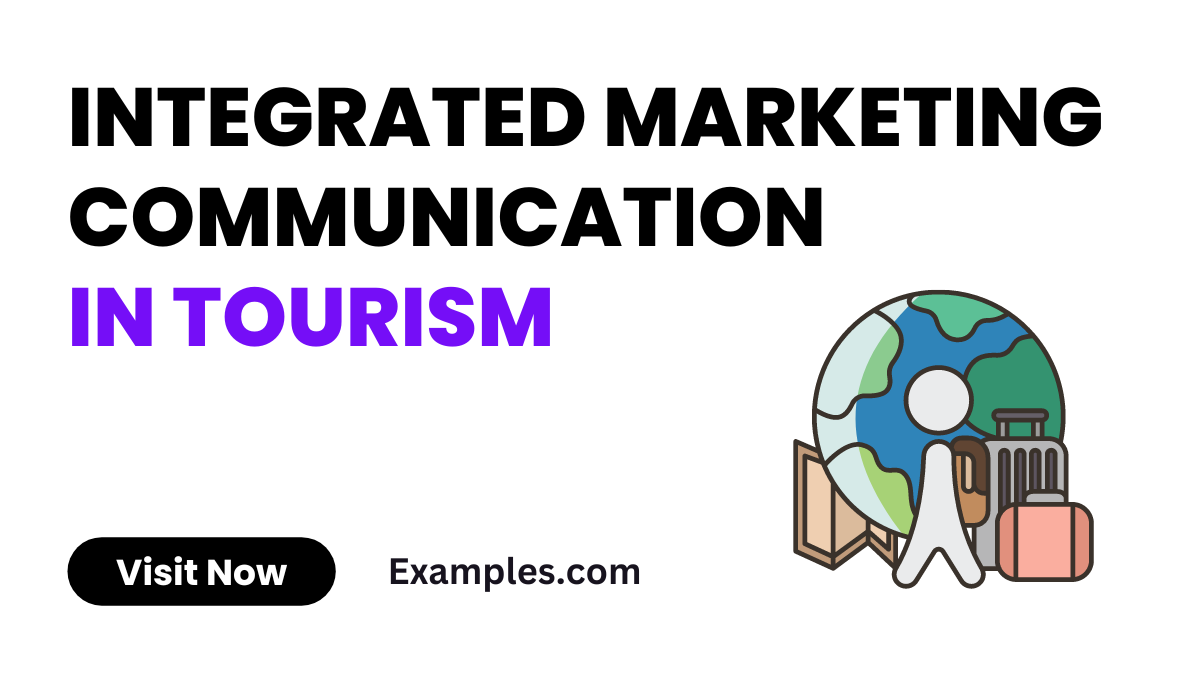19+ Integrated Marketing Communication in Tourism Examples
Embark on a journey through the intricate world of tourism marketing. Explore the synergy of diverse communication channels that create a seamless and enticing experience for travelers. Discover strategies, insights, and vivid communication examples that bring destinations to life, making them irresistible to a global audience.
What is Integrated Marketing Communication in Tourism?

Integrated Marketing Communication in Tourism refers to the coordinated use of various promotional methods to deliver a unified and compelling message, ensuring a consistent brand image within the travel industry.
What is the Best Example of Integrated Marketing Communication in Tourism?

The “I Amsterdam” campaign in Amsterdam, Netherlands, showcases a superb example of Integrated Marketing Communication in tourism. This initiative seamlessly combines advertising, social media, events, and partnerships to promote Amsterdam as a vibrant and diverse tourist destination. It effectively communicates the city’s unique culture, attractions, and experiences, resulting in increased tourism and a consistent brand image.
20 Integrated Marketing Communication in Tourism Examples

Exploring the intricacies of Integrated Marketing Communication (IMC) in tourism unveils a world where captivating storytelling, innovative technologies, and community engagement converge to shape vibrant destinations. This guide delves into the essence of tourism promotion, offering insights into creating cohesive brand narratives, leveraging diverse channels, and embracing sustainable practices. Navigate the dynamic landscape of tourism marketing with strategic communication, fostering an emotional connection that resonates with travelers globally.
- Virtual Reality Experiences: Transport potential tourists to the destination through immersive VR experiences showcasing key attractions.
- Culinary Trails and Guides: Develop engaging guides that lead visitors through culinary adventures, highlighting local eateries and unique dishes.
- Live Streaming Events: Host live-streamed events, from cultural performances to scenic views, allowing audiences worldwide to participate in real-time.
- Geo-Targeted Social Ads: Utilize geo-targeted advertisements on platforms like Facebook, reaching users based on their location and travel interests.
- Interactive Destination Maps: Create interactive maps that provide users with a visually appealing and informative way to explore the destination.
- Local Art Installations: Collaborate with local artists for public art installations that capture the spirit of the destination and serve as iconic landmarks.
- Destination Podcast Series: Launch a podcast series featuring locals, travel experts, and influencers sharing captivating stories and insights.
- Sustainable Tourism Campaigns: Showcase the destination’s commitment to sustainability through campaigns emphasizing eco-friendly practices and responsible tourism.
- Augmented Reality Souvenirs: Introduce AR-powered souvenirs that come to life when scanned, offering a unique and memorable keepsake for visitors.
- Themed Social Media Challenges: Create challenges on platforms like Instagram or TikTok, encouraging users to share their experiences with specific themes.
- Collaborative Travel Blogging: Partner with travel bloggers to co-create engaging content, combining local insights with the blogger’s unique perspective.
- Destination Ambassador Programs: Establish ambassador programs with locals who embody the destination’s spirit, sharing their stories and experiences.
- User-Generated Content Contests: Run contests encouraging visitors to share photos and stories, amplifying user-generated content and fostering a sense of community.
- Story-driven Video Campaigns: Craft narrative-driven videos that tell compelling stories about the destination, capturing the essence and emotions of travel.
- Smart City Integration: Implement smart city initiatives, integrating technology for smoother navigation, information access, and enhanced visitor experiences.
- Community Engagement Workshops: Conduct workshops involving the local community to share insights, ideas, and contributions for tourism development.
- Seasonal Travel Guides: Release seasonal travel guides, showcasing the destination’s unique charm during different times of the year.
- Localized Language Apps: Develop language apps that assist tourists with common phrases, ensuring seamless communication and cultural immersion.
- Heritage Conservation Initiatives: Launch initiatives aimed at preserving and promoting the destination’s heritage, fostering a sense of pride among locals and attracting culturally inclined tourists.
- Customizable Travel Packages: Offer customizable travel packages, allowing visitors to tailor their itineraries based on personal preferences and interests.
Integrated Marketing Communication in Tourism Examples for Business
Elevate your business’s presence in the tourism realm with strategic Integrated Marketing Communication (IMC). Unleash captivating campaigns, leverage technology, and forge partnerships to entice travelers. This guide unveils innovative approaches tailored for businesses, ensuring a memorable and impactful presence in the competitive tourism landscape.
- Corporate Retreat Packages: Craft exclusive packages for businesses, enticing them with tailored retreats that blend work and leisure seamlessly.
- B2B Collaborative Events: Organize industry-specific events, fostering networking opportunities and showcasing the destination’s appeal to businesses.
- Destination Team-building: Curate team-building activities set in the destination, offering a unique blend of professional development and exploration.
- Executive Travel Blogs: Encourage executives to share their travel experiences through blogs, creating a personal touch that resonates with potential corporate visitors.
- Digital Conferencing Showcase: Highlight the destination’s advanced digital infrastructure through a showcase aimed at attracting conferences and seminars.
Integrated Marketing Communication in Tourism Examples for Students
Ignite students’ wanderlust by integrating vibrant marketing communication into tourism initiatives. This guide navigates academia’s intersection with tourism, offering creative ideas to engage students, from educational travel programs to immersive learning experiences that transcend traditional classroom boundaries.
- Study Abroad Webinars: Host engaging webinars showcasing the benefits and experiences of studying abroad, encouraging students to explore new educational horizons.
- Cultural Exchange Programs: Develop programs that facilitate cultural exchange, allowing students to immerse themselves in diverse global communities.
- Educational Tourism Challenges: Launch challenges that merge educational goals with travel experiences, encouraging students to pursue knowledge beyond textbooks.
- Virtual Reality Campus Tours: Provide virtual reality tours of tourist destinations, allowing students to explore potential travel spots in an immersive and educational manner.
- Internship Opportunities: Collaborate with tourism-related businesses to create internship opportunities, allowing students to gain practical experience while discovering new destinations.
How does Integrated Marketing Communication play a Role in Promoting Tourism Destinations?
In modern tourism dynamics, Integrated Marketing Communication (IMC) plays a pivotal role in promoting destinations effectively. IMC weaves diverse promotional elements into compelling narratives. Here are six steps showcasing how IMC strategically contributes to tourism promotion:
- Brand Positioning: Craft a unique brand identity for the destination and align communication channels to reinforce this positioning.
- Digital Presence: Establish a comprehensive digital presence using websites, social media, and travel platforms for engaging content.
- Content Marketing: Develop and distribute relevant, engaging content tailored to the target audience’s preferences.
- Collaborative Partnerships: Forge partnerships with influencers, local businesses, and tourism boards for collaborative campaigns.
- Multichannel Campaigns: Implement cohesive multichannel campaigns across traditional and digital platforms for a consistent message.
- Visitor Engagement Programs: Design interactive programs, contests, and virtual experiences to encourage user-generated content and community building.
What are the Components of Effective Integrated Marketing Communication in the Tourism Industry?
Effective Integrated Marketing Communication (IMC) in the tourism industry requires a strategic blend of various components. From online platforms to traditional advertising, each element plays a crucial role in creating a cohesive and compelling tourism campaign. This guide unveils the essential components that contribute to successful IMC in the dynamic world of tourism.
- Targeted Messaging: Craft messages tailored to specific traveler demographics, ensuring resonance with diverse audiences.
- Visual Storytelling: Utilize compelling visuals, such as photos, videos, and virtual experiences, to evoke emotions and showcase the destination’s allure.
- Cross-Channel Consistency: Maintain consistency in messaging across various channels, ensuring a harmonized brand image and message.
- Strategic Partnerships: Forge collaborations with influencers, travel bloggers, and businesses to amplify the reach of tourism campaigns.
- Real-time Engagement: Leverage real-time engagement on social media, responding promptly to inquiries and fostering a sense of community.
- Data-Driven Insights: Utilize data analytics to understand traveler behavior, preferences, and market trends, enabling informed decision-making in IMC strategies.
How Social Media Platforms Play in Shaping Integrated Marketing Communication for Tourism Purposes?
Introduction: Social media has revolutionized tourism marketing, providing an expansive platform to engage, inspire, and connect with travelers worldwide. This guide delves into the pivotal role social media platforms play in shaping Integrated Marketing Communication (IMC) strategies within the tourism industry.
Six Steps in Shaping IMC through Social Media:
- Platform Selection: Identify the most relevant social media platforms based on the target audience, focusing on platforms popular among travel enthusiasts.
- Engaging Content Creation: Develop visually appealing and shareable content, including stunning visuals, informative videos, and captivating narratives.
- Interactive Campaigns: Launch interactive campaigns, contests, and challenges to encourage user participation and generate user-generated content.
- Influencer Collaborations: Partner with travel influencers to amplify reach, leveraging their credibility to promote tourism experiences authentically.
- Community Building: Foster a sense of community by responding to comments, sharing user-generated content, and creating a space for travelers to connect.
- Analytics and Optimization: Utilize social media analytics to measure the effectiveness of campaigns, understand audience engagement, and optimize strategies for continuous improvement.
In conclusion, Integrated Marketing Communication (IMC) proves indispensable in the dynamic landscape of tourism. Its strategic implementation, as illustrated by the diverse examples, serves as a comprehensive guide for destination promotion. As we navigate the realms of IMC in tourism, it becomes evident that a cohesive, multichannel approach is the key to creating lasting impressions and enticing travelers worldwide.



